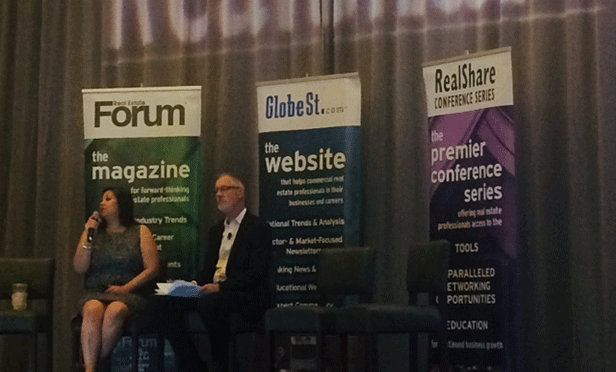 ALM's Sule Aygoren moderates the opening session at RealShare Healthcare with keynote speaker Mark Stapp.
ALM's Sule Aygoren moderates the opening session at RealShare Healthcare with keynote speaker Mark Stapp.
SCOTTSDALE, AZ—While the direction of healthcare policy continues to be uncertain, the demand for medical space remains high. During RealShare Healthcare's opening keynote economic outlook, speaker Mark Stapp, Fred E. Taylor Professor of real estate and executive director of the masters of real estate development program at Arizona State University's W.P. Carey School of Business, said that public policy, technology and psychographics are among some of the major drivers in the healthcare sector today.
“Population change and not just demographics but psychographics are going to have a tremendous impact on the type of use and the quality of medical healthcare space,” he said. “Psychographics is an important element in analyzing places in terms of demand, site selection and looks at populations in terms of values, behavior, how people make decisions and more.”
He continues that “As we better understand populations, we can better position space to accommodate that. Demographics doesn't tell us what we like to do.”
What real estate is, he said, is ultimately the nexus between business and society. “It is a service and as society changes, the demand for space changes.”
He pointed out that “You begin to think about what society needs and wants.” He adds that every community has a variety of types of capital. “The health capital of a place isn't always thought about, but should be. Businesses are interested in hiring people that are healthy—they are more productive and cheaper to employ. Wellness and the idea of pursuing wellness becomes an increasingly important capital.”
One of the things that is changing today is people's desire to be healthy, he explained. “Wellness is becoming a driver. How we have to provide space to meet people where they normally live and work is important. It isn't about fixing us when we are broke it is about keeping us not get broke. I think we are going to see populations and values seek to reduce demand by seeking healthier lifestyles.”
And incorporating WELL building standards as well as increasing flexible space is something we can expect to see more of in the healthcare space and is something people should be looking at as a competitive advantage, he added. “I don't know how you avoid not coupling wellness with business because it will become too important to how we run cost effective reliable businesses.”
“The healthcare industry is ripe for the same kinds of impacts that have occurred in other segments of our economy. One of the things that technology is doing is that it is giving us access,” he said. “People are going to find business models that solve inefficiency.”
He explained that we will continue to see a movement towards convergence towards our physical and digital self and the use of that to better deliver services. “What you are going to see is people looking at how we use technology to connect medical providers and users.”
Keep checking back in the next few days for much more from the RealShare Healthcare event.
© Touchpoint Markets, All Rights Reserved. Request academic re-use from www.copyright.com. All other uses, submit a request to [email protected]. For more inforrmation visit Asset & Logo Licensing.







